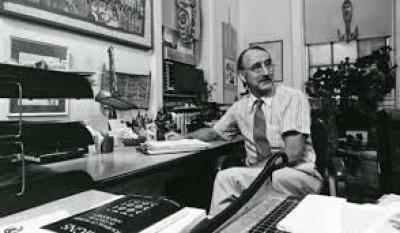Collapse of gender partition dissolved patriarchies & opened way to UN-led activism
Our post religious neo-pagan era owes its advent to an academic figure who clinically dismantled biological gender division and in doing so became a one-man latter-day reformation pushing church teachings utterly and conclusively aside in favour of the elemental lore so evident today.
Rarely has any such tidal movement in contemporary culture been quite so traceable to a single individual which in this case is to Dr John Money (pictured) who ushered in the age of gender neutrality.
He effectively in doing so demolished the wall that hitherto had securely partitioned science from the populace at large,
In toppling the concept of patriarchy he eroded the standing of other dominant hierarchies. Dr Money kick-started a new reconstructed and fluid ethical framework.
Dr Money dissolved the gender binary boundary and ignited the new non-patriarchal orthodoxy of social equity subscribed to most notably by United Nations. One in which for example juveniles can challenge on equal footing science professionals of any standing.
Dr Money’s influence extended to introducing terminology that we take for granted today. He took the word gender out of its exclusively grammatical context and applied it to humans as in terms such as gender role and gender identity.
He was the first clinician to describe himself as a sexologist and to be officially described as such. He was the pioneering exponent in child rearing of the "nurture versus nature" concept in gender assignment.
Dr Money contended that if the gender of the young child was nurtured by the parents as that gender, then it could be that its behavioural characteristics and not its physical ones (nature) would decide whether it was male or female.
This is a variant on the livestock breeder axiom of nature versus nurture which Dr Money would have picked up growing up in the New Zealand dairy farming settlement of Morrinsville.
His arrival as the decisive agent of human biology-driven cultural change intersected with the counter culture. Rolling Stone among other avatars popularised his research about what was known at the time as gender bending.
Dr Money studied psychology at Victoria University in Wellington before taking up a junior lectureship at Otago University.
He emigrated to the United States becoming a research fellow at Johns Hopkins University for more than 50 years.
His fame came as director of the Psychohormonal Research Unit at Johns Hopkins in Baltimore, and he authored some 40 books on sexology.
He established the Johns Hopkins Gender Identity Clinic in 1965 .The hospital began performing sexual reassignment surgery in 1966.
He retired only two years before his death at 85 in 2006.
The weight accorded Dr Money’s work on gender had much to do with his long association with Ivy League universities notably Johns Hopkins the original medical research university in the United States. His Phd was from Harvard
The man who collapsed the watertight door between science and humanities preferred the company of artists to scientists.
Often considered difficult and prickly by his colleagues, Dr Money’s work made him rich and his philanthropy took the form of investment in art, especially primitive art which he gathered during his constant travelling.
Except for his eponymous collection bequeathed to the art gallery in Gore, New Zealand, he remains an uncommemorated figure in the country of his birth, and indeed also in the United States.
A collection of his professional writings is housed at the library of the Kinsey Institute for Research in Sex, Gender and Reproduction at Indiana University.
How was it that someone from a modest background and from a remote part of the world became such a watershed figure in the cultural direction of the west, U-turning it in such a compressed period of time?
His emergence from far beyond the mainstream was coupled with an instinct for the centre and a disdain for criticism. He understood before it entered the mainstream the true outcome of the fusion of the twin cultures into the social sciences and inserted himself into the fulcrum, the point at which he could exert the greatest leverage which was gender identity.

